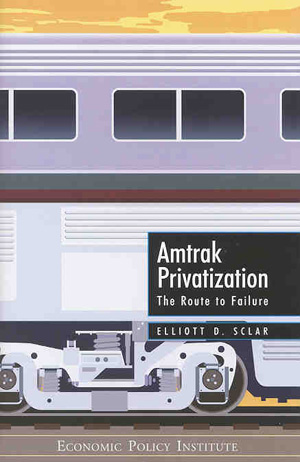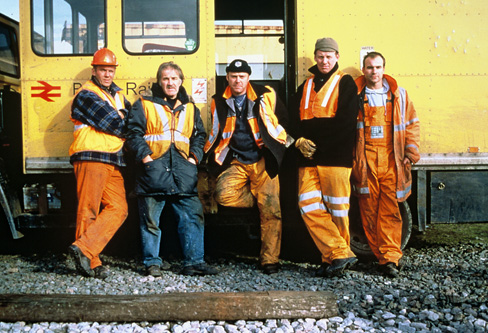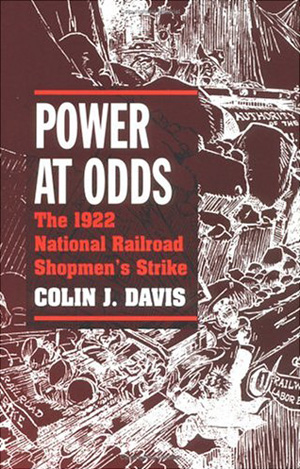The threatened New York City Transit strike is just the latest sign of a growing labor-management confrontation across the US railroad system.
While the workers of Transit Workers Union 100 battle off attacks on their pensions and health care, Bush Administration hirelings on the Amtrak Board prepare to launch an assault on the national passenger system. Their first step in the campaign was to fire Amtrak President David Gunn.
They want to break Amtrak up into pieces and privatize it, focusing particularly on the passenger-rich Northeast Corridor, where they plan a scheme that would make the infrastructure of the rails and signals a separate company from the trains that run on them, a scheme modeled on the break up of British Rail in the UK back in the nineties.
At the moment, Amtrak limps along on a pitiful Federal subsidy of less than 2 billion a year, while Federal largess is poured into highways and airports, not to mention the Iraq War.
The UK privatization was pushed through in the waning days of Tory rule under John Major. It led to endless snafus and angry passengers, punctuated by some horrific derailments, as the profit-hungry contractors responsible for track maintenance skimped on inspections and repairs. The situation became so bad that the neo-con Blair Labor Party was forced into terminating Railtrack, the private entity set up for the rails and partially renationalizing it, having it taken over by Network Rail, a public company that does not pay tax-payer subsidized dividends as Railtrack did.
If you can find a copy, I highly recommend film-maker Ken Loach‘s The Navigators, a gritty account of the effects of privatization on rank and file British track workers.
Now, even as the battle lines are drawn in the passenger rail sector in the US, trouble looms on the hugely profitable freight rail sector.
Rail workers in freight must negotiate under the terms of the Railway Labor Act of 1926, a set of regulations brought about as a reaction to the great railroad Shop Strike of 1922, when 400,000 shop workers of the steam era fought against the just re-privatized railroad monopolies which Wilson had been forced to nationalize during World War I, due to their gross inefficiencies. It’s a little known fact that the shop workers voted 99% to maintain the nationalized rail system immediately after the war.
The Railway Labor Act sets numerous limits to the railroad workers’ right to strike, in exchange for contracts remaining in place past expiration, with the process ending with Congressional and Presidential intervention, usually invoked to order strikers back to work. In the last round of negotiations, talks dragged on far past contract terminations, far past even by the standards of the RLA.
In the latest round of so-called negotiations, being carried on again on already expired contracts, the Teamsters have organized a group of rail unions to bargain as a coalition. In a press release dated December 15, the Teamster Coalition informs us that the rail carriers have broken off the talks.
“The NCCC’s refusal is mystifying,” said Freddie Simpson, President of the Brotherhood of Maintenance of Way Employees (BMWE), “It is premature to refuse to bargain over the serious items both sides have placed on the table. What this round of negotiations needs is patience, hard work and willingness on both sides to listen and respond meaningfully to the other’s issues. We have scarcely begun this process when suddenly the carriers up and walk away from the table.”
While it may be mystifying to Brother Simpson — and I know he may be playing to the galleries here — it is no mystery to me what the railroad corporations are up to. In my two decades in the industry, various labor coalitions have been formed to bargain, always with the same result. First of all, there has never been a united front of all rail unions in these negotiations. The coalitions have been partial, as is the current Teamster group. As talks drag on, one or two of the coalition partners drop out, seeking a better deal on their own.
Meanwhile, the carriers’ national bargaining group sticks together. In 1992 they shut the whole freight rail system down and locked out the workers, in response to one railroad being struck, falsely claiming that the railroads could not be run elsewhere safely. They were then able to force Congress to intervene and impose a settlement.
The carriers look for one union of the fifteen or so that still exist in the rail system and make a deal that becomes a pattern for future arbitration. With one domino down, it simply becomes a matter of getting the rest to tip over. And tip over they do, even as the former partners point the finger at each other, until the last domino plops, and the coalition-building can start all over.
Many railroad workers are getting a little fed up with this charade. What exactly is the point of a partial coalition anyway? Why on earth should the railroad bosses negotiate with half the rail unions when they have the option of making a deal with one and play another game of dominos? Inquiring minds want to know. Railroad workers deserve better. We need to demand some accountability from our leaders before another divide-and-conquer session goes down.
From what I have seen so far, the New York City Transit Workers are mobilizing seriously for such accountability from their leaders. Let’s hope they set a good example for the rest of rail labor to follow.





